2025 May
Top 10 Things You Shouldn’t Miss in Rio (Including That Caipirinha on the Beach)
by Evi


So you’ve made it to Rio de Janeiro—the vibrant, dramatic, sometimes chaotic, always samba-infused gem of Brazil. Congratulations! Now, with so much to see and do (and eat), you’ll need a game plan that goes beyond snapping a photo of Cristo with your arms wide open. We’ve rounded up the must-dos, must-sees, and absolutely must-eats based on our own epic Rio adventure.


1.Cristo Redentor
Let’s start with the obvious: Christ the Redeemer. It’s on every postcard for a reason. It was created by French-Polish sculptor Paul Landowsk and constructed between 1922 and 1931, the statue is 30 meters high and is overlooking Rio with its open arms. To reach Christ the Redeemer, you can take the Corcovado Train from Cosme Velho, the official Paineiras-Corcovado vans from various city points like Copacabana, or hike through the Tijuca National Forest starting at Parque Lage. The Corcovado Train is a scenic and popular choice, while the vans offer comfort and convenience.
Book your Cosme Velho cable car tickets online here for the first time slot of the day and trust us, it’s the only way to beat the selfie-stick crowd and actually enjoy the view. But check the weather first, we booked our tickets after we arrived in Rio so we can be sure that the sky would be clear to enjoy the views!
How to get there: Take an Uber to the Trem do Corcovado station in Cosme Velho. Easy, cheap, and chill.
2.Sugarloaf Mountain – For That Sunset Glow
A cable car ride that ends in panoramic bliss. Rising 396 m above the harbor, the peak of the mountain is named for its resemblance to the traditional shape of concentrated refined loaf sugar. It is known worldwide for its cableway and panoramic views of the city and beyond. Go up in the late afternoon, and watch the city, ocean, and sky put on a show as the sun dips behind the hills. We booked our tickets online here
How to get there:
Take an Uber to Praia Vermelha, where the Sugarloaf cable car station is. Book your tickets online in advance to skip the line. It’s touristy but worth every real.
3.Rocinha Favela Tour – Real Rio
You’ll never understand Rio without stepping into Rocinha, Latin America’s largest favela. Rocinha is built on a steep hillside overlooking Rio de Janeiro, and is located about one kilometer from a nearby beach. Most of the favela is on a very steep hill, with many trees surrounding it. Around 70,000 people live in Rocinha, making it the most populous in Rio de Janeiro. It developed from a shanty town into an urbanized slum. Today, almost all the houses in Rocinha are made from concrete and brick. Some buildings are three and four storeys tall and almost all houses have basic plumbing and electricity. Compared to simple shanty towns or slums, Rocinha has a better developed infrastructure and hundreds of businesses and services such as schools, a hospital, banks, pharmacies, restaurants, including a local based channel TV ROC.
You can book a walking tour like the one we booked through Airbnb Experiences. We met our guide at São Conrado metro, took a bike ride to the top and then spent hours learning about the vibrant community, life in the favela, and the insane views from its rooftops. Safe, eye-opening, unforgettable.
Pro-tip: In rainy days, the tours are usually cancelled, so plan ahead and check your weather app!




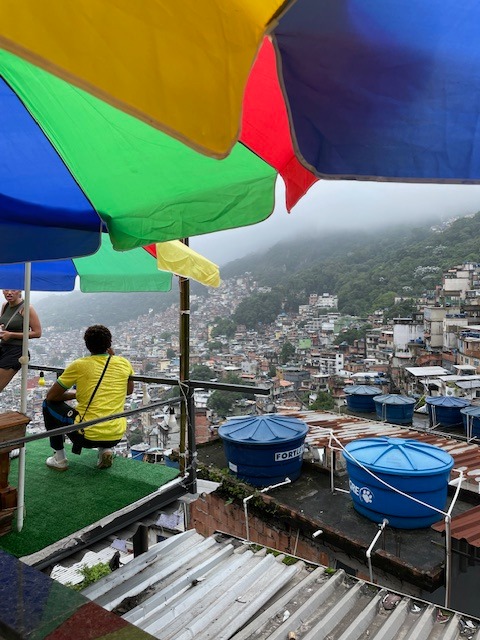

4.Centro + Santa Teresa Combo Walk
Rio de Janeiro's Centro district reflects Brazil's evolution from its colonial monarchy to its republican era, evolving from the city's foundational port and financial center into a modern hub of culture, finance, and historical landmarks. Once the center of the city's emotional and cultural life, Centro also holds complex historical layers, including the birthplace of samba in the Gamboa neighborhood and its connection to the history of slavery in Brazil. As Rio de Janeiro grew, the area remained a prominent center, with historic buildings and roads showcasing key periods in Brazilian history, including the time of the monarchy. Start your day with a cultural stroll in Rio Centro, see the Real Gabinete Português de Leitura (it’s straight out of Hogwarts), the Theatro Municipal, and Catedral Metropolitana.
Then hop on the iconic Santa Teresa tram from Largo da Carioca, glide over the Arcos da Lapa, and explore this bohemian hilltop neighborhood. Having run continuously since its opening in 1877 (except for a 2011–15 suspension), Santa Teresa tram is one of the oldest street railway lines in the world. It has been electrically powered since 1896, being the oldest electric railway in all of Latin America. Don’t miss Largo dos Guimarães for coffee and artisan shops.
Bonus: Make a pit stop at the famous Selarón Steps, because your Instagram demands it. The steps were originally a simple, early 20th-century staircase, but were transformed into a vibrant mosaic masterpiece by Chilean artist Jorge Selarón starting in 1990. Selarón decorated the 215 steps outside his home with ceramic tiles, initially in the colors of the Brazilian flag, but later adding tiles from over 120 countries as a personal tribute to the Brazilian people.
5.Ipanema & Copacabana – Beach Like a Local
Sure, you’ve heard the song. But nothing prepares you for the vibe of Ipanema and Copacabana in real life. Locals in speedos, beach volleyball legends, live samba beats, and caipirinhas that magically keep appearing. Rent a chair, grab a Caipirinha or a mate com limão, and of course a Biscoito Globo, sweet or sour, it doesn't matter, from one of the many cariocas and soak it all in.
A sip of History: Copacabana was initially called Sacopenapã by the local indigenous people before a chapel dedicated to the Virgen de Copacabana was built in the 18th century, giving the neighborhood its name. The area was incorporated into the city of Rio de Janeiro in 1892, with urban people flocking to build summer houses. The neighborhood reached its peak glamour in the mid-20th century, with a grand architecture characterized by buildings from the 1950s and 60s. The Copacabana Palace was built, and the iconic curving mosaic sidewalk, designed by Roberto Burle Marx in the 1970s, features wave patterns symbolizing the meeting of the river and the sea. Ipanema was initially populated by indigenous Tupi people. The urbanization began in 1902 with the introduction of a streetcar line to encourage more people to live there. In the 1960s, the neighborhood gained international fame through the bossa nova song "The Girl from Ipanema," and the area around Posto 9 became a hub for artists and intellectuals. By the 1960s, Ipanema developed into a sophisticated and upscale neighborhood, known for its wider sidewalks, modern infrastructure, and fashionable crowds.
6.Maracanã Stadium – Football Fan or Not
You don’t have to know the offside rule to appreciate the sheer energy of Maracanã, one of the world’s most iconic stadiums. The Maracanã Stadium was built for the 1950 FIFA World Cup, opening on June 16 1950, with a match between the Carioca and Paulista. Initially the world's largest stadium, it once held almost 200,000 spectators but now has a capacity of about 79,000 after renovations. Its history includes hosting World Cup finals in 1950 and 2014, the opening and closing ceremonies of the 2016 Olympic Games, Pelé's 1,000th career goal, and serving as the iconic home of Brazilian football. Take a guided tour, walk through the locker rooms, and stood pitch-side pretending to be Neymar. Tickets can be purchased on-line or at the box office of the stadium, located at Gate A for pedestrians and for cars by parking at gate 2, open from 8:30 AM to 4:30 PM.
Pro tip: Check if there’s a match during your stay. You’ll never see football the same way again.
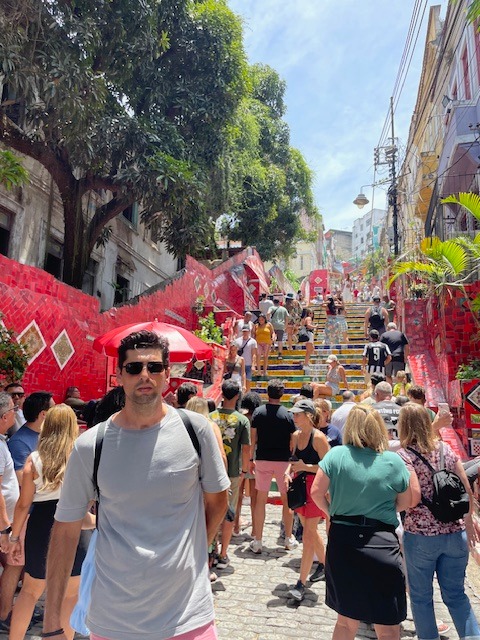





7.Day Trip to Búzios – Brigitte Was Right
Búzios began as a strategic port for French pirates and indigenous tribes in the 16th century, later becoming a center for whale hunting in the 18th century and a quiet fishing village from the 18th century until the 1960s. Its history dramatically shifted in 1964. Búzios became Brazil’s chicest coastal escape after Brigitte Bardot discovered it in the ’60s, transforming the sleepy town into an international glamour destination, a reputation it maintains today as a sophisticated coastal resort town. Take a day trip, like this one that we booked from GetYourGuide, which includes transfers, a boat ride around the beaches, and lunch.
Expect: Cobblestone streets, stunning beaches, turquoise waters, and that laid-back glam vibe.
Travel time: Around 2.5 hours one-way by car/van from Rio.
8.Alternative Day Trip: Ilha Grande – Paradise Found
If island vibes are more your thing, opt for Ilha Grande instead. Ilha Grande is a forested, car-free island known for its preserved Atlantic Forest, mountainous terrain, and numerous beaches, ideal for hiking, camping, and water activities like kayaking and diving. You can snorkel, hike, or just float around in crystalline water.
How to get there: Day tours are available from Rio and include land + boat transfers.
Warning: you might not want to come back.
9.Eat Like a Local: Rodízio & Beyond
You cannot leave Brazil without experiencing a proper rodízio. It is an all-you-can-eat Brazilian style of restaurant service where waiters bring a continuous selection of grilled meats on skewers directly to your table for you to have carved onto your plate. The experience is typically priced at a fixed rate and starts with a gourmet salad bar offering a wide variety of fresh items. Diners control the flow of meat by using a two-sided token, flipping it to the "yes" side for more meat and the "no" side to signal they've had enough.
We chose Fogo de Chão, and it was a meat-lover’s dream: sizzling picanha, lamb, sausages, served nonstop until you flip your coaster to red. Come hungry. Very hungry.
Other eats not to miss in Rio:
Arrumadinho at Bodega do Sal – a typical northeast Brazilian dish with meat, beans, and farofa.
Pastéis from street vendors – deep-fried pastry pockets of joy.
Açaí bowls – best enjoyed by the beach.
Pão de queijo – tiny cheese puffs = your new addiction.
10.Mercado Popular Uruguaiana & RioSul Mall
Yes, we also shopped. When it rained (and oh, it did), we ducked into RioSul Mall for a proper retail fix. On sunnier days, we explored the buzzing Mercado Popular Uruguaiana, a maze of market stalls selling everything from flip flops to Brazilian snacks. And yes Havaianas are way cheaper in Brazil!
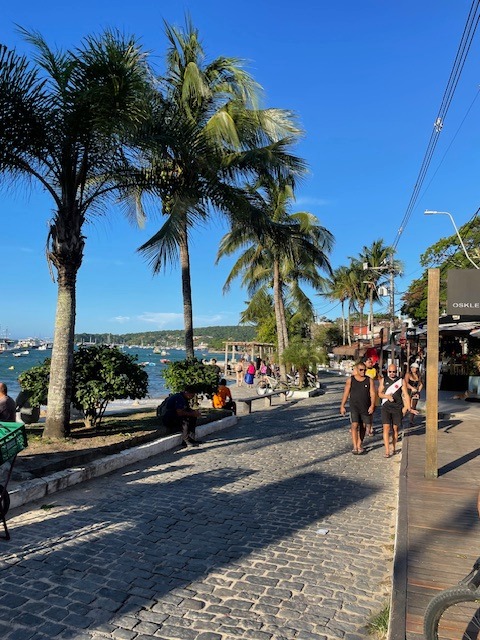

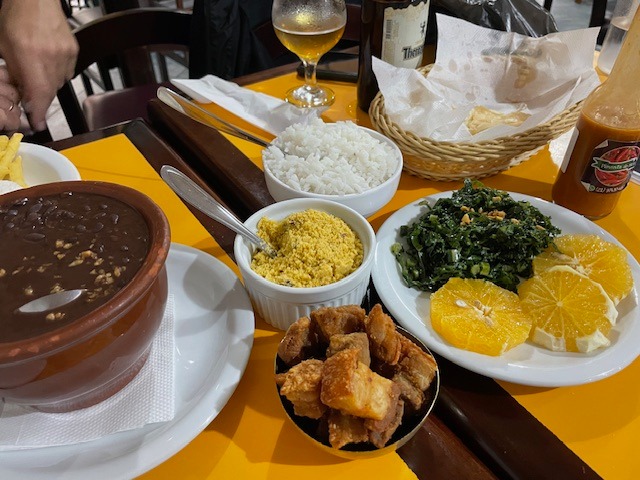

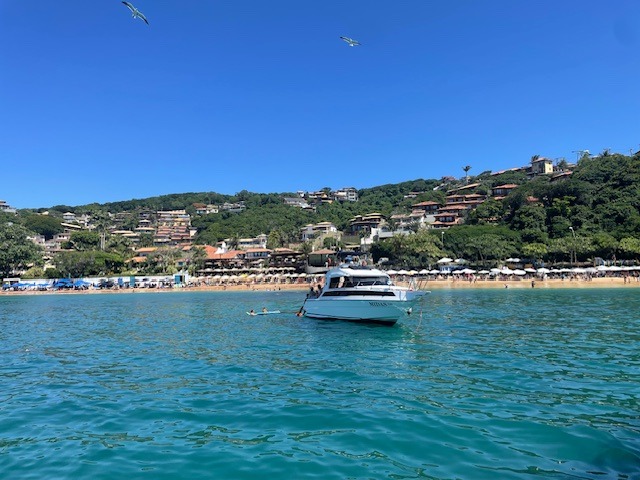

When is the best time to visit Rio?
The best time to visit Rio de Janeiro really depends on the kind of experience you’re after, but most travelers will find December to March the most exciting season. These summer months bring hot, sunny weather that’s perfect for lounging on Copacabana or Ipanema, marvel the views over Christ the Redeemer, and soaking in the city’s vibrant beach culture. This is also when Rio hosts its world-famous Carnival (usually February or early March), a once-in-a-lifetime spectacle of parades, samba, and street parties. If you prefer fewer crowds and milder weather, aim for the shoulder months of April to June or September to November, temperatures are still warm, prices are more reasonable, and you’ll enjoy a more relaxed vibe while still catching plenty of sunshine.


Getting Around Rio like a Pro
Getting around Rio de Janeiro is easier than you might expect, and you’ve got a few solid options depending on your mood and plans. Uber is king here, it’s cheap, safe, and everywhere. Every ride is stress-free: polite drivers, clean cars, and smooth navigation through the city’s winding streets. If you want to avoid traffic (which in Rio can be legendary), the Rio Metro is a lifesaver. It’s modern, safe, and efficient, with air-conditioned trains and stations close to major attractions like Copacabana and Ipanema. The best part? You can easily buy tickets using your credit or debit card at the blue “Crédito e Débito” machines, no need for cash. For short trips, you can also hop on yellow taxis, though they’re pricier than Uber. Between the metro for speed and Uber for convenience, you’ll have no problem moving around Rio smoothly while soaking in the city’s vibrant energy.


How to Stay Connected in Rio
Staying connected in Rio de Janeiro isn’t just about posting beach photos, it’s your lifeline for maps, Ubers, translations, and general travel sanity. We used the Revolut eSIM, and it was a game changer: one digital SIM that worked seamlessly across Brazil, Argentina, and Uruguay, no swapping SIM cards, no hunting for kiosks, no stress. If you want flexibility, other global eSIM providers like Airalo or Nomad are also excellent options, letting you purchase and activate data plans before you even land.
If you prefer the traditional route, local SIM cards are easy to find at the airport or major malls. Popular providers include Vivo, Claro, and TIM. Vivo generally has the best nationwide coverage, Claro offers solid data packages, and TIM can be a budget-friendly choice. Expect to pay around R$30–50 ($6–10 USD) for a prepaid plan with a good chunk of data.
Most hotels, Airbnbs, and cafés have free Wi-Fi, but don’t rely on it as your main connection. For peace of mind, especially when navigating Rio’s sprawling neighborhoods or ordering an Uber late at night, a reliable SIM or eSIM is worth every cent.


Is Rio Safe?
Safety in Rio de Janeiro is one of those topics every traveler wonders about and the answer is nuanced. During the day, it’s generally safe to ride the metro, stroll along Copacabana or Ipanema, and explore Centro for its historic sights. We did all of these and felt comfortable, as long as we stayed aware of our surroundings. That said, Rio changes completely at night. After dark, it’s best to avoid public transportation and long walks especially through empty streets. An Uber is your safest bet to get back to your accommodation, even for short distances.
While Centro is home to Rio’s most important cultural landmarks, like the Municipal Theater, Selarón Steps, and Cathedral of Rio, it can feel chaotic. You’ll see homeless people sleeping on benches and a general grittiness that contrasts sharply with Rio’s postcard-perfect beaches. It doesn’t mean you shouldn’t visit it’s part of the reality of the city but be prepared for the mix of beauty and hardship existing side by side.
Rio is also a city of striking contrasts. On one hand, you have the polished neighborhoods of Copacabana, Ipanema, and Botafogo, with their buzzing nightlife, golden beaches, and trendy restaurants, plus sleek areas like Marina da Glória, where yachts glisten under the sun. On the other hand, the sprawling favelas and the less polished Centro reflect the challenges of a vast metropolitan city: poverty, inequality, and the everyday hustle of survival. These contrasts are part of what makes Rio fascinating, glamour and struggle coexisting just a few blocks apart.
A few extra tips: don’t flash jewelry, watches, or the latest iPhone, carry only what you need for the day, and keep a small amount of cash handy for quick transactions. Like any big city, petty theft can happen, but with common sense and precaution, Rio can be enjoyed safely. Think of it this way: by day, explore freely, by night, lean on ride-hailing apps and trusted spots near your stay. That balance will let you soak in Rio’s magic while keeping peace of mind.


Drop us a comment bellow
Top Things to Do in Rio
Rio is messy, magical, moody, and magnificent. It’s the kind of place that stays with you long after your tan fades. Whether you’re climbing up Sugarloaf or dancing down the steps of Selarón, eating your weight in picanha or sipping caipirinhas by the sea—Rio is not a city you visit. It’s a city you feel.
Check our other post for Brazil
Top 10 Things You Should do in Rio
Now, with so much to see and do, you’ll need a game plan that goes beyond snapping a photo of Cristo with your arms wide open. We’ve rounded up the must-dos, must-sees, and absolutely must-eats based on our own Rio adventure. Top 10 Things You Should do in Rio.
Evi
5/15/202512 min read
